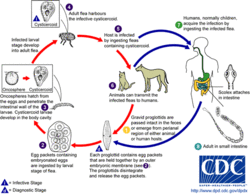Dipylidium caninum
| Cucumber tapeworm | |
|---|---|
 | |
| Scientific classification | |
| Kingdom: | Animalia |
| Phylum: | Platyhelminthes |
| Class: | Cestoda |
| Order: | Cyclophyllidea |
| Family: | Dipylidiidae |
| Genus: | Dipylidium |
| Species: | D. caninum |
| Binomial name | |
| Dipylidium caninum | |

Dipylidium caninum, also called the flea tapeworm or the double-pore tapeworm, is a cyclophyllid cestode that infects organisms afflicted with fleas and canine chewing lice, including dogs, cats, and pet-owners, especially children. Adult worms are about 18 inches (46 cm) long. Gravid proglottids containing the worm's microscopic eggs are either passed in the definitive host's feces or may leave their host spontaneously and are then ingested by flea larvae (the intermediate hosts) in the surrounding environment. These larvae eventually pupate and transform into adult fleas which are then ingested by a dog or cat during grooming activity. Examples of fleas that can spread D. caninum include Ctenocephalides canis and Ctenocephalides felis.
As in all members of family Dipylidiidae, proglottids of the adult worm have genital pores on both sides (hence the name double-pore tapeworm). Each side has a set of male and female reproductive organs. The uterus is paired with 16 to 20 radial branches each. The scolex has a retractable rostellum with four rows of hooks, along with the four suckers that all cyclophyllid cestodes have.
In children, infection causes diarrhea and restlessness. As with most tapeworm infections, the drugs of choice are niclosamide or praziquantel. The best way to prevent human infection is to treat infected animals to kill fleas. Tapeworm infection usually does not cause pathology in the dog or cat.
The other tapeworm commonly infecting cats is Taenia taeniaeformis.
Gallery
-
Dipylidium caninum egg packet
-
Dipylidium caninum proglottid
-

Dipylidium caninum
-
Dipylidium caninum worms


